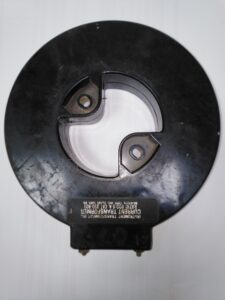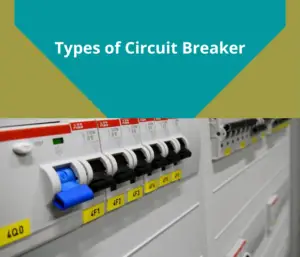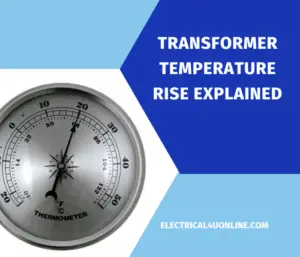A Current Transformer (CT) is an essential device used in electrical systems to measure and monitor current in a conductor or circuit without directly connecting to high-voltage systems.
It is widely employed in power distribution, generation, and industrial applications for measurement, protection, and control purposes. Here’s an overview of its key aspects:
Table of Contents
What is a Current Transformer?
A CT is a type of instrument transformer that steps down a high current in the primary circuit to a lower, measurable current in its secondary circuit, maintaining accurate proportionality.
How Does It Work?
- Primary Winding: The current to be measured flows through this winding. Typically, it has one or a few turns.
- Secondary Winding: Connected to measuring instruments or protective relays, this winding carries a current proportional to the primary current.
- Magnetic Core: Transfers the magnetic flux generated by the primary current to the secondary winding.
The relationship is given by:
Ip⋅Np = Is⋅Ns
Where:
Ip = Primary current
Np = Number of turns in the primary winding
Is = Secondary current
Ns = Number of turns in the secondary winding
Key Features
- Step-Down Current: Reduces high currents to a standard level (e.g., 5A or 1A) for safe measurement and analysis.
- Isolation: Electrically isolates the measuring devices from the high-voltage circuit.
- Accuracy: Ensures precise current measurement, especially within its designed range.
For more information read my other article, Current Transformer Answers For Beginners!
Types of Current Transformers
Current Transformers (CTs) come in different designs, each suited to specific applications. Understanding these types helps to select the right CT for measurement or protection purposes. Here’s a detailed explanation:
- Bar-Type CT: A solid or bus conductor acts as the primary winding.
- Wound CT: The primary winding consists of a separate coil.
- Toroidal CT: Lacks a primary winding; the conductor is passed through its core.
- Protection CTs: Designed for use in protective relay circuits, often with a focus on accuracy during fault conditions.
- Metering CTs: Optimized for precise measurement under normal operating conditions.
1. Bar-Type CT
- Description:
The primary conductor itself acts as the primary winding of the transformer. Typically, this conductor is a solid bar or busbar that passes through the CT’s magnetic core. - Applications:
- High-current applications, such as power distribution and substations.
- Often used in situations where the current to be measured is very high and the conductor is large.
- Advantages:
- Simple construction and installation.
- High mechanical strength.
- Example Use: Measuring current in large power distribution panels.
2. Wound-Type CT
- Description:
In this type, the primary winding is a coil directly wound around the CT’s core. The number of turns in the primary winding can vary depending on the design. - Applications:
- Low to medium current systems.
- Used in specialized equipment where flexibility in primary winding design is needed.
- Advantages:
- Precise control over the primary-to-secondary ratio.
- Example Use: Laboratory testing equipment or control panels in industrial systems.
3. Toroidal CT
- Description:
A toroidal CT has a donut-shaped magnetic core without a built-in primary winding. The conductor carrying the current passes through the center of the CT. - Applications:
- Retrofits or installations where it’s easier to pass an existing conductor through the CT.
- Often used in metering and monitoring applications.
- Advantages:
- Compact and lightweight design.
- Easy to install on existing conductors without disconnecting them.
- Example Use: Monitoring current distribution boards or panels.
4. Protection CTs
- Description:
These CTs are designed specifically for use with protective devices like relays. They operate accurately during fault conditions, even when the current is much higher than normal. - Applications:
- Power system protection, such as detecting faults like short circuits or overcurrent.
- Often used in circuit breakers or protective relaying systems.
- Advantages:
- Can handle very high currents during fault conditions without saturating.
- Designed to trigger protective relays reliably.
- Example Use: In high-voltage substations to protect transformers and cables.
5. Metering CTs
- Description:
These CTs are optimized for precise current measurement under normal operating conditions. They are not designed to handle fault-level currents. - Applications:
- Accurate energy metering and monitoring in residential, commercial, or industrial systems.
- Advantages:
- High accuracy for billing and monitoring purposes.
- Stable performance under normal conditions.
- Example Use: In energy meters to monitor power consumption.
Summary Table
| Type | Primary Design | Main Use | Key Feature |
|---|---|---|---|
| Bar-Type | Solid bar conductor | High-current systems | Simple, robust, easy to install |
| Wound-Type | Coiled primary | Low/medium current | Precise primary-to-secondary ratio |
| Toroidal | No primary winding | Retrofits/monitoring | Compact, easy installation |
| Protection CT | Coil-based | Protection systems | Accurate during faults |
| Metering CT | Coil-based | Energy monitoring | High accuracy for normal conditions |
Choosing the Right CT
When selecting a CT, consider:
- Current Levels: What is the maximum current in the system?
- Purpose: Is it for measurement, protection, or both?
- Installation Needs: Is it a new setup or a retrofit?
- Accuracy Requirements: Metering CTs require high accuracy, while protection CTs prioritize reliability under fault conditions.
Applications
- Measurement: Used in ammeters, wattmeters, energy meters, and other devices to monitor electrical loads.
- Protection: Provides current input to protective relays in case of overcurrent, short circuits, or other faults.
- Monitoring: Helps monitor and record electrical parameters for maintenance and energy management.
Key Ratings and Specifications
- Rated Primary and Secondary Current: Typically marked as 200/5A or 1000/1A, indicating the transformation ratio.
- Accuracy Class: Specifies how closely the CT measures current, e.g., 0.5, 1.0 (metering) or 5P, 10P (protection).
- Burden: The load (in VA) that the CT can drive without exceeding its accuracy limits.
- Saturation Point: Indicates the current level at which the CT core saturates and loses accuracy.
Installation Considerations
- Ensure the CT is installed correctly with the polarity marks (P1, P2 for primary; S1, S2 for secondary) aligned as per the system’s current direction.
- The secondary winding must never be left open-circuited while the primary carries current, as this can cause dangerously high voltages.
Safety Precautions
- Always short-circuit the secondary terminals when the CT is not connected to a load.
- Handle with care during installation to avoid core damage or inaccurate measurements.
By transforming high currents into safe, measurable values, CTs are vital for the efficient and safe operation of electrical power systems.
Toroidal-type current transformer
Don’t Leave Empty-Handed!
Install my Free Android App on Google Play:
Electrical Cables Most Common Tables “Cables Tables”
And, my Electrical Calculations App “Fast Electrical Calculator”
Discover more great content by subscribing to My channel
Looking to stay ahead of the game in the world of electrical engineering? Subscribe to my YouTube channel and gain access to exclusive content you won’t find anywhere else!
The staff I recommend
(Amazon Affiliate Links to products I believe are high quality):
- Economy 120 Volt/60Hz AC Power Source – Step-Down Voltage & Frequency Converters 1800W
- UNI-T Digital Multimeter Tester UT139C
- 50-Amp Extension Cord for RV “100ft”
- Voltage Stabilizer 110/220v
- Hair Dryer “best selling“
- TOSHIBA EM131A5C-BS Countertop Microwave Ovens
Disclaimer: This contains affiliate links to Amazon products. I may earn a commission for purchases made through these links.



